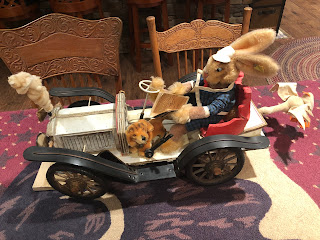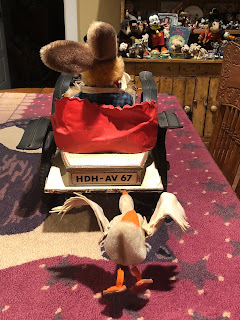So let's kick off 2022 in fifth gear! It's always so much fun to learn about unusual Steiff display pieces, and this one will make you want to hit the road for sure. What secrets do its design elements hold? Check out this note and photos from Susie in Ohio. She shares,
"This is a wonderful Steiff display piece I own that I call "Distracted Driving!" It has a Lulac, a Cockie, and a Tulla Goose. When you push the car, the goose wings flap up and down and the cotton smoke stack in the front rotates. It is in pretty great condition although some of it is made from rubber and has become slightly brittle. This does not distract from its irresistible charm. I honestly think this display should be in a museum somewhere!"
A joy ride indeed! Steiff's tradition of creating still and animated displays goes back to the dawn of the 20th century. These first, early vignettes reflected things like life in a small town, farming, schoolrooms, or sports, among others. In some cases, these were photographed for advertising purposes, while in others, the scenes were actually sold as a package to stores as displays. It wouldn't be long before Steiff's creative team brought these scenes to the next level with movement; in about 1910 the company launched the large-scale, mechanized window display pieces that it would continue to produce throughout the 20th century. Albert Schlopsnies, a design and creative freelancer for the company, is responsible for many of Steiff's most breathtaking museum, retail, exhibit, and special event displays through the mid-1920s.
Now let's take a closer look at Susie's display. Its passengers include two standard line items and one modified standard line item. Given its form, materials, and detailing, it is Steiffgal's best guess that this display was made sometime in the c. 1955-1965 timeframe. Steiff used the "old jalopy" car concept in its automaton production frequently throughout the third quarter of the 20th century. Here on the left you can see a similarly themed display from the late 1970s or so; the photo is from LiveAuctioneers/Morphy Auctions.
Lulac's wingman is a standing Bazi dog. He is made from short tan colored mohair that is accentuated with darker airbrushed highlights on his back, chest, and head. Bazi's face is detailed with black and brown pupil eyes and a hand embroidered nose and mouth. Bazi left the factory in Giengen wearing a blue leather collar with a little brass bell. The standing mohair version of Bazi was produced in 10 and 14 cm from 1950 through 1975. Given the presentation of the display, it is Steiffgal's best guess that this is the 10 cm version. You can see standing Bazi here on the left, the photo is from Steiffgal's collection.
At the tail end of all of this - and yes, pun intended - looks to be a little Tulla goose, sort of. Regular line Tullas are standing, unjointed, and made entirely from white mohair with grey airbrushed highlights, especially on their heads and necks. They feature playful, outstretched mohair wings, oversized orange felt feet, and a thin, happy orange felt beak which really looks like a smile! Their back tail feathers are made from a solid piece of single thick white felt, and their faces are detailed with tiny black button eyes. Tulla goose was made from 1952 through 1974 in 12, 17, and 28 cm. You can see Steiff's 12 cm standard line Tulla goose here on the left, the photo is from Steiffgal's collection.
If you look closely at the goose on this display, you will notice that she has a few small design details that are different than her standard line cousins. First, her tail is made from orange felt, not white felt. Second, her wings are made from white felt, not white mohair. And finally, her orange beak is much larger and more prominent than the standard line version's beak. It is entirely possible that these simple modifications were made so the goose would have the physical structure, critical mass, and flexibility to hold her position on the display, as well as flap her wings when activated.
Steiffgal hopes this discussion on Susie's animated Steiff automobile display has been the real-wheel-deal for you!
Have a question about one of your Steiff treasures? Let's talk! Click here to learn more.







